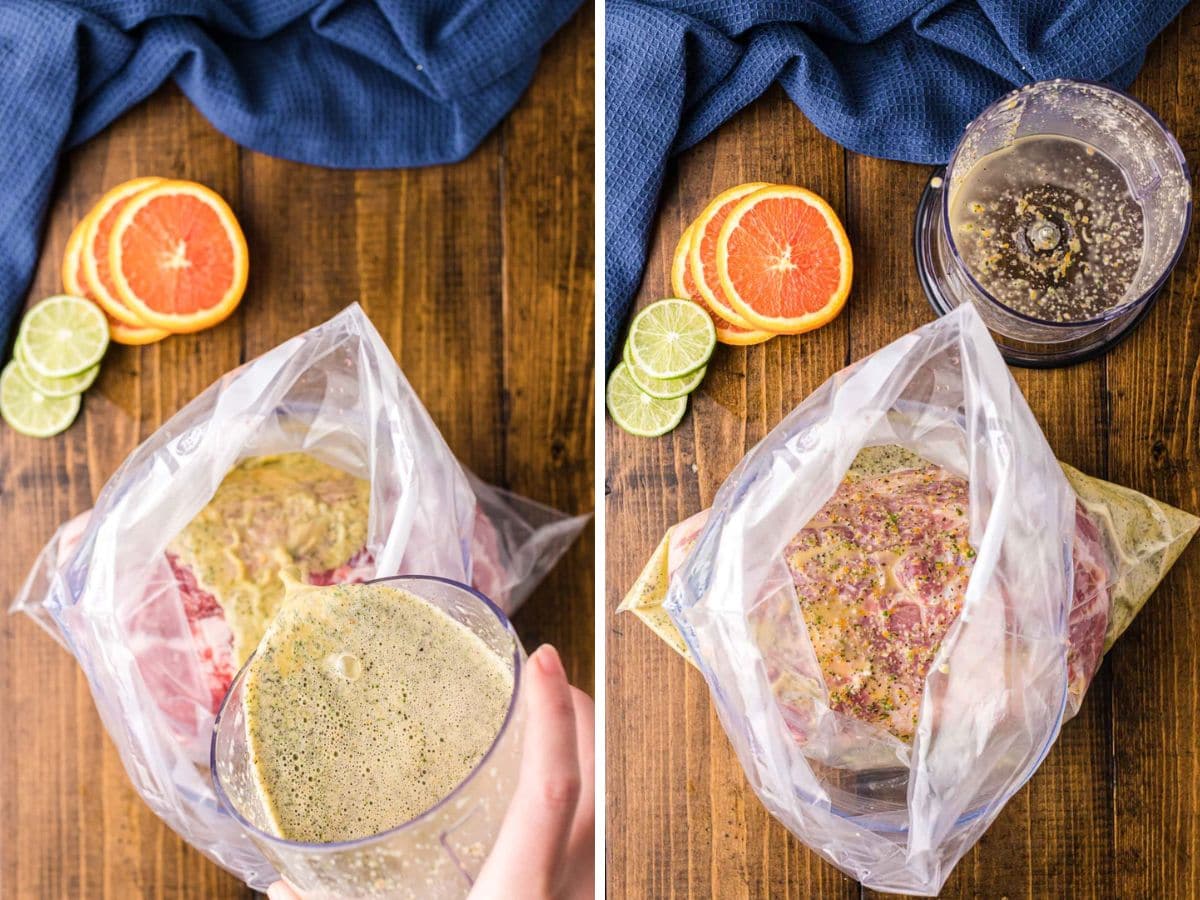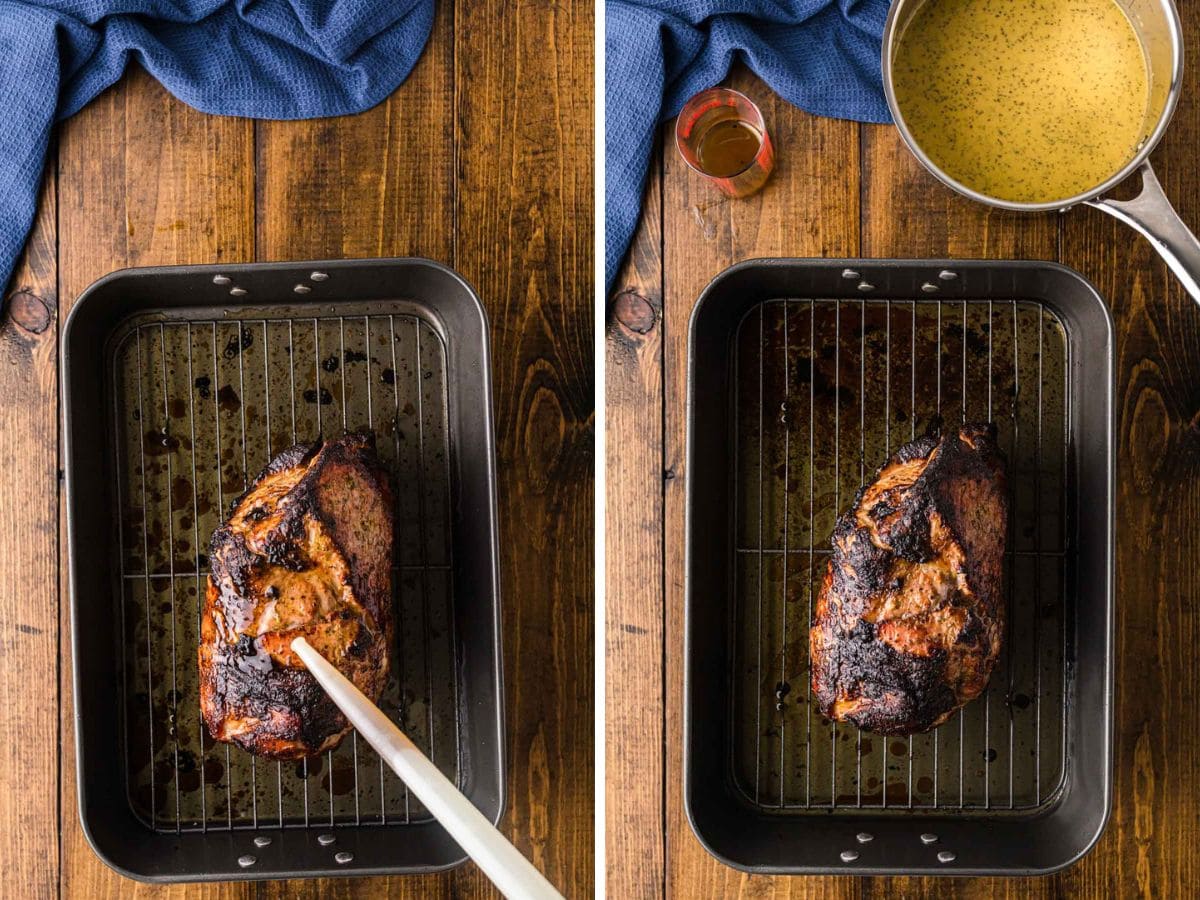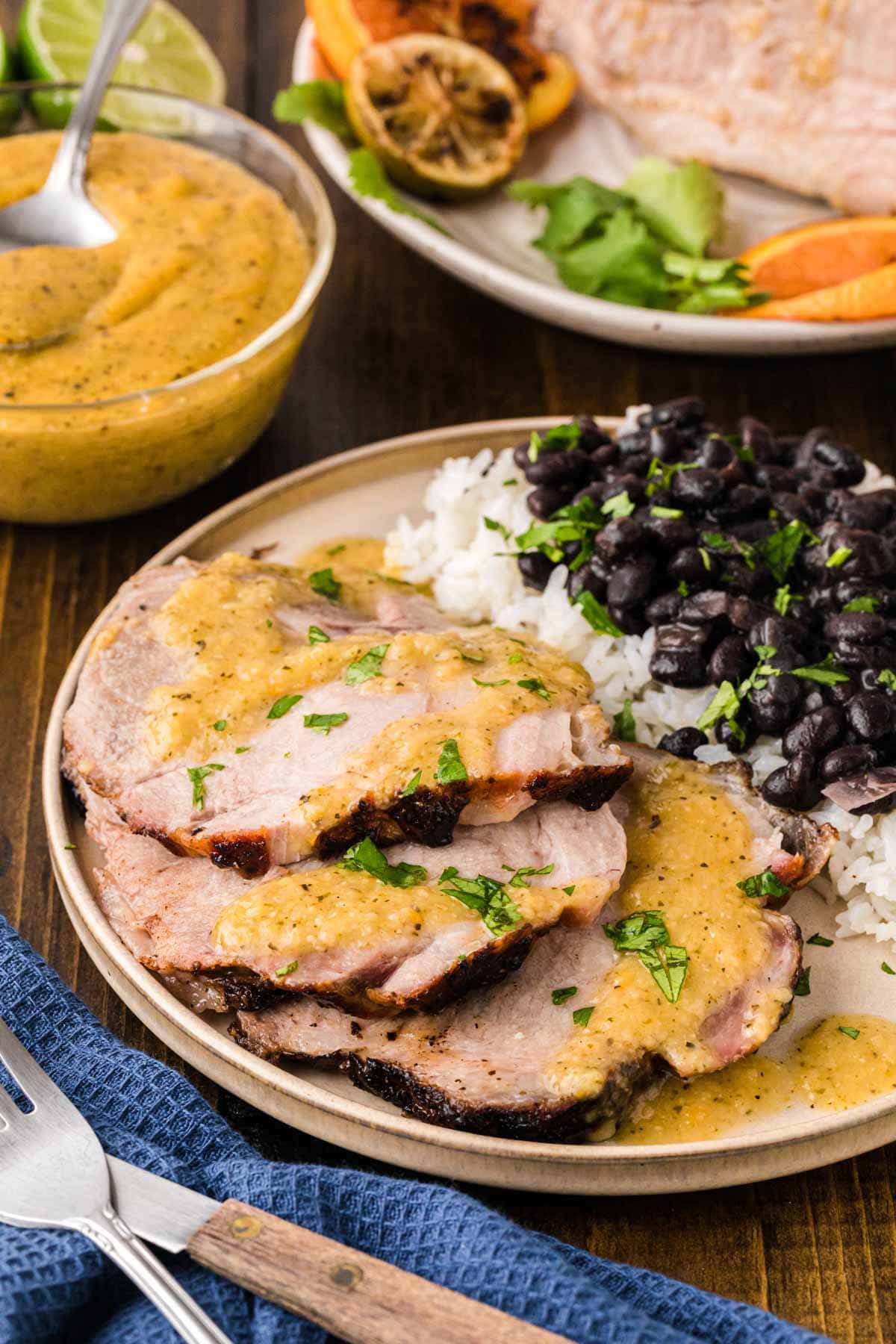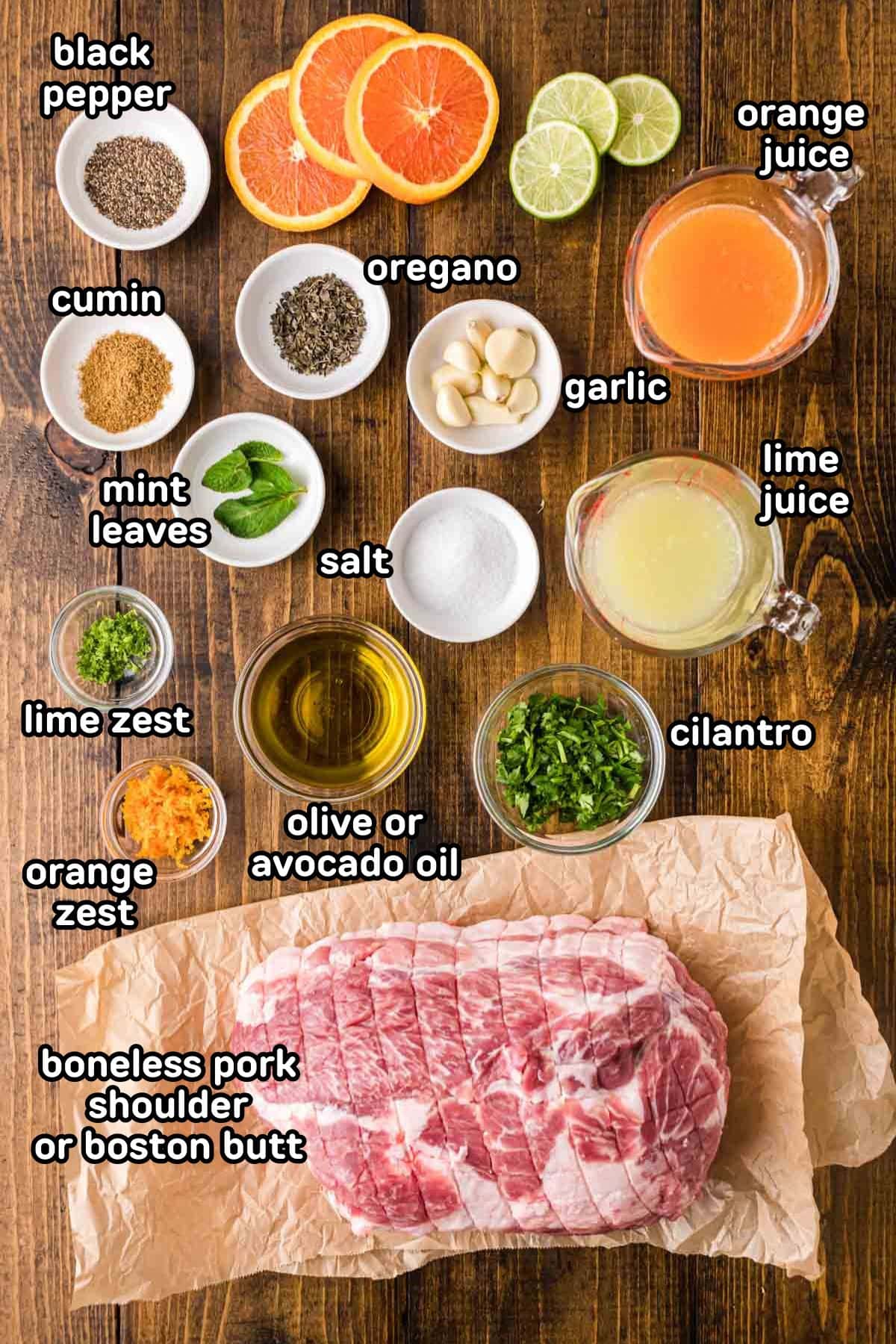This post may contain affiliate links. Please read our disclosure policy.
If you’re craving juicy, mojo-marinated pork with rich, authentic flavor, this Cuban Pork Roast is the one to make. My version brings bold, citrus-garlic flavor with simple, clear steps that take the guesswork out of this classic dish. It’s a true crowd-pleaser that’s just as perfect for Sunday dinner as it is for a special gathering.

Living in the Tampa area, Cuban food has always been close to my heart. I’ve grown up around the flavors, traditions, and stories that make this cuisine so special. Whether it was meals shared with friends or local restaurants that felt like home, Cuban cooking has been part of my life for as long as I can remember. This pork roast, or lechón asado, is a dish that brings those memories to the table.
This version is full of bold, authentic flavor but keeps things simple enough for any home cook. It starts with a homemade mojo marinade made from fresh citrus, garlic, and warm spices. Letting the pork marinate for at least 3 to 4 hours (or overnight if you have the time) is key to getting that deep, rich flavor and juicy tenderness.
If you’re looking for a more hands-off option, I’ve also shared a Slow Cooker Cuban Pork Roast that works beautifully for busy days when you still want something comforting and full of flavor.
This is the kind of meal that invites people in and keeps them at the table a little longer. It’s full of heart, rooted in tradition, and meant to be shared.
Nikki’s Recipe Rundown
- Taste: Bright, garlicky, citrusy, and deeply savory.
- Texture: Tender and juicy with a beautifully golden crust!
- Ease: Simple to prepare—just marinate, roast, and enjoy.
- Pros: Cuban pork is flavorful, versatile, and great to feed a crowd.
- Considerations: Needs marinating time and a longer roast for shredding, so patience is key!
How to Roast Cuban Pork
✱ Be sure to see the recipe card below for exact ingredients and full recipe instructions!
Step 1 | Marinate the Pork
Combine all the marinade ingredients in a food processor blender and pulse until the herbs and garlic are finely chopped.

Place the pork in a large zip-top bag and pour the marinade over it, and seal the bag. Toss the pork around in the bag to coat thoroughly. Place the orange and lime slices in the bag on top of the roast. Place the bag in a bowl and refrigerate for at least 3 – 4 hours or overnight.

No food processor? Finely chop the herbs and garlic, then mix everything in a bowl. Place the pork in a large enough bowl to put the pork in it.
I prefer not to use a shallow bowl so that the pork will sit down in the marinade. Pour the marinade over it, and toss to coat.
Place in the refrigerator overnight, preferably, or for at least 3 – 4 hours, for the flavors to come together. If using a ziplock bag, I like to put the bag in a bowl, just in case there are any spills.

Step 2 | Prep for Roasting
Take the pork out of the fridge and let it rest on the counter for about 1 hour so it comes to room temperature. Don’t forget to reserve the marinade—we’ll use it for the sauce later! Discard the fruit slices. (Keep it refrigerated while the meat is cooking.)
Preheat your oven to 425°F or 400°F if using a convection or fan oven.
Step 3 | Roast the Pork
Place the pork in a roasting pan, uncovered, and roast for 30 minutes to get a nice golden crust. Baste the pork with the pan juices a couple of times during this step.

Reduce the oven temperature to 375°F or 350°F ( convection/fan). Continue roasting for another 1½ to 2 hours, basting every 30 minutes * See Note (this is optional- if you wrap tightly and aren’t able to baste it still turns out delicious). The pork is ready when the internal temperature hits 160°F —juicy and tender but still sliceable.

For pork you can shred: Lower the oven temp to 325°F and roast for about 3 to 3 ½ hours, or until the meat easily shreds with a fork.
If you would like to crisp the top more, place the roast in the oven on broil for a few minutes. Keep an eye on it.
Step 4 | Make Mojo Sauce & Serve
In a small saucepan, combine the reserved marinade, 2 tablespoons of the roasting pan dripping.
Bring it to a gentle boil, then reduce the heat to a simmer. Let it cook for about 2-3 minutes.
Taste and adjust the flavor as needed. A little extra lime juice will brighten it up, or a pinch of sugar can balance the tanginess if it’s too tart for your liking.

Once the pork is done, transfer it to a plate and loosely cover it with foil. Let it rest for about 20 minutes to let all those juices redistribute into the pork.
If you want a similar slow cooker version, try my Crockpot Mojo Cuban Pork Recipe!
Cuban Pork Recipe Variations & Substitutions
- Bone-In Pork Shoulder: You can use bone-in for more flavor and slightly juicier meat. Just increase the cook time by about 30–45 minutes depending on the size.
- No Fresh Citrus? While fresh is ideal, you can substitute bottled juices in a pinch. Try to use high-quality, 100% juice without added sugar— I like this one.
- No Cilantro? Swap it for parsley if you’re not a fan. It changes the flavor, but the result is still delicious.
- Slow Cooker Method: Marinate the pork as directed, then cook on low for 8–10 hours. You won’t get that crispy crust, but it’ll shred beautifully.
Recipe Tips
- Marinate overnight if possible. The longer the pork marinates, the more flavorful it becomes. Overnight is ideal for deeply infused flavor!
- Let it come to room temperature before roasting. This step helps the pork cook evenly and prevents it from drying out in the oven.
- Don’t skip the resting time! Letting the meat rest after roasting helps lock in juices and makes slicing or shredding easier.
- Adjust the mojo sauce to taste. Don’t forget to taste your sauce before serving! A splash more citrus or a touch of sugar can fine-tune it perfectly according to your taste.

Want to Save this Recipe?
By submitting this form, you consent to receive emails from Soulfully Made.
Storage
Storage: Store leftover pork in an airtight container in the refrigerator for up to 4 days. Reheat gently in the oven or on the stovetop with a splash of broth or leftover mojo sauce to keep it from drying out.
Freeze: You can also freeze portions for easy meals later—just thaw overnight in the fridge before reheating.
What to Serve with Cuban Roasted Pork
Cuban pork pairs beautifully with traditional sides like Spanish rice and Cuban black beans. For something a little fresher, try it with a simple cabbage slaw, avocado slices, or a tangy tomato and cucumber salad.
It’s also incredible tucked into Cuban sandwiches with pickles and Swiss cheese or piled onto warm tortillas. Don’t forget a drizzle of that citrusy mojo sauce on everything—it ties the whole plate together!

Cuban Roast Pork FAQs
A Dutch oven or heavy-duty baking dish will work too. Just ensure it’s oven-safe and large enough to hold the pork.
Lechón asado is a traditional Cuban roast pork dish made with marinated pork shoulder, typically flavored with citrus, garlic, herbs, and spices. While generally cooked over a spit and roasted slowly over a fire, in this case it’s slow-roasted in the oven until tender, juicy, which gives a similar result to the traditional version!
Pork shoulder is done when it reaches an internal temperature of 160°F for slicing or 190–200°F for shredding. It should be fork-tender, juicy, and pull apart easily if you’re going for a more traditional, fall-apart texture.
For this Cuban pork roast, you’ll want to start roasting at a high temperature—425°F (or 400°F if you’re using a convection oven)—to create that golden, flavorful crust. After about 30 minutes, reduce the heat to 375°F (or 350°F convection) and continue roasting until the pork reaches an internal temperature of 160°F. This gives you a juicy roast that’s still sliceable.
If you’re after a shredded-style pork, lower the oven temperature to 325°F and roast for 3 to 3 ½ hours, or until the pork is fall-apart tender and easily shreds with a fork.
Be sure to let the pork rest before slicing or shredding. That little bit of time helps the juices settle back into the meat, making every bite tender and flavorful.
Other Recipes to Try
- Authentic Cuban Sandwich
- Collard Greens Wrapped Pork Roast
- Slow Cooker Cuban Mojo Pork
- Chicken Burrito Bowl
- Mississippi Pot Roast
Hungry for more easy, home-cooked, delicious recipes?
Sign up for my free recipe club to get family-friendly recipes in your inbox each week! Find me sharing daily meal-time inspiration on Pinterest, Facebook, and Instagram.

Cuban Pork Shoulder (Lechon Asado)
Click Stars To Rate
Ingredients
- 4 pounds boneless pork shoulder - Boston Butt works great!
- ¼ cup olive oil - or avocado oil if you prefer
- ¼ cup fresh cilantro
- 1 tablespoon orange zest
- ¾ cup fresh orange juice - (about 3-4 medium navel oranges)
- 1 teaspoon lime zest
- ½ cup fresh lime juice - (about 4-5 limes)
- 3-4 fresh mint leaves
- 6-8 garlic cloves
- 1 teaspoon dried oregano
- 1 teaspoon ground cumin
- 1-2 teaspoons kosher salt - adjust to taste
- 1 teaspoon black pepper
- Optional: I like to slice an orange and lime to go in with the marinade
Instructions
- Combine all the marinade ingredients in a food processor blender and pulse until the herbs and garlic are finely chopped. Place the pork in a large zip-top bag and pour the marinade over it, and seal the bag. Toss the pork around in the bag to coat thoroughly. Place orange and lime slices in the bag on top of the roast. Place the bag in a bowl and refrigerate for at least 3 – 4 hours or overnight.
- If you don't have a food processor, finely chop the herbs and garlic, then mix everything in a bowl. Place the pork in a large enough bowl to put the pork in it. I prefer not to use a shallow bowl so that the pork will sit down in the marinade. Pour the marinade over it, and toss to coat.
- Place in the refrigerator for overnight preferably or for at least 3 – 4 hours, for the flavors to come together. If using a ziplock bag, I like to put the bag in a bowl—just in case there are any spills.
- Take the pork out of the fridge and let it rest on the counter for about 1 hour so it comes to room temperature. Don’t forget to reserve the marinade—we’ll use it for the sauce later! Discard the fruit slices. (Keep it refrigerated while the meat is cooking.)
- Preheat your oven to 425°F or 400°F if using a convection or fan oven.
- Place the pork in a roasting pan, uncovered, and roast for 30 minutes to get a nice golden crust. Baste the pork with the pan juices a couple of times during this step.
- Reduce the oven temperature to 375°F or 350°F ( convection/fan). Continue roasting for another 1½ to 2 hours, basting every 30 minutes * See Note (this is optional- if you wrap tightly and aren’t able to baste it still turns out delicious). The pork is ready when the internal temperature hits 160°F —juicy and tender but still sliceable.
- For pork you can shred: Lower the oven temp to 325°F and roast for about 3 to 3 ½ hours, or until the meat easily shreds with a fork.
- If you would like to crisp the top more, place the roast in the oven on broil for a few minutes. Keep an eye on it.
- Once the pork is done, transfer it to a plate and loosely cover it with foil. Let it rest for about 20 minutes to let all those juices redistribute into the pork.
- In a small saucepan, combine the reserved marinade, 2 tablespoons of the roasting pan dripping.
- Bring it to a gentle boil, then reduce the heat to a simmer. Let it cook for about a 2-3 minutes.
- Taste and adjust the flavor as needed. A little extra lime juice will brighten it up, or a pinch of sugar can balance the tanginess if it’s too tart for your liking.
Notes
- If you want to thicken the sauce add 3 tablespoons of cornstarch to ¼ cup of cold water and whisk until smooth. Pour into the sauce and stir. Let it cook for a couple of minutes until thickened.
- To brighten up the mojo sauce you can add extra 3-4 tablespoons orange juice and 1-2 tablespoons of lime juice, if you like. Salt and Pepper to taste if desired. I find with the lime and orange slices in the marinade, you don’t necessarily need to do this.
- Bottled Orange juices can be a little sweeter than fresh squeezed orange juice.
Basting is optional– if you wrap tightly and aren’t able to baste it still turns out delicious. If you find you do not have any liquid from the pan drippings and you can add some water or broth to the pan as you cook or after to use in the mojo sauce. Gravy: If you would like to make a gravy, follow my Turkey Gravy recipe but use these drippings. If drippings are lacking you can add 4 tablespoons of butter to the pan and scrape up any bits from the bottom. Then proceed with recipe (you will lift flavor from the bottom of the pan).
Want to Save this Recipe?
By submitting this form, you consent to receive emails from Soulfully Made.







